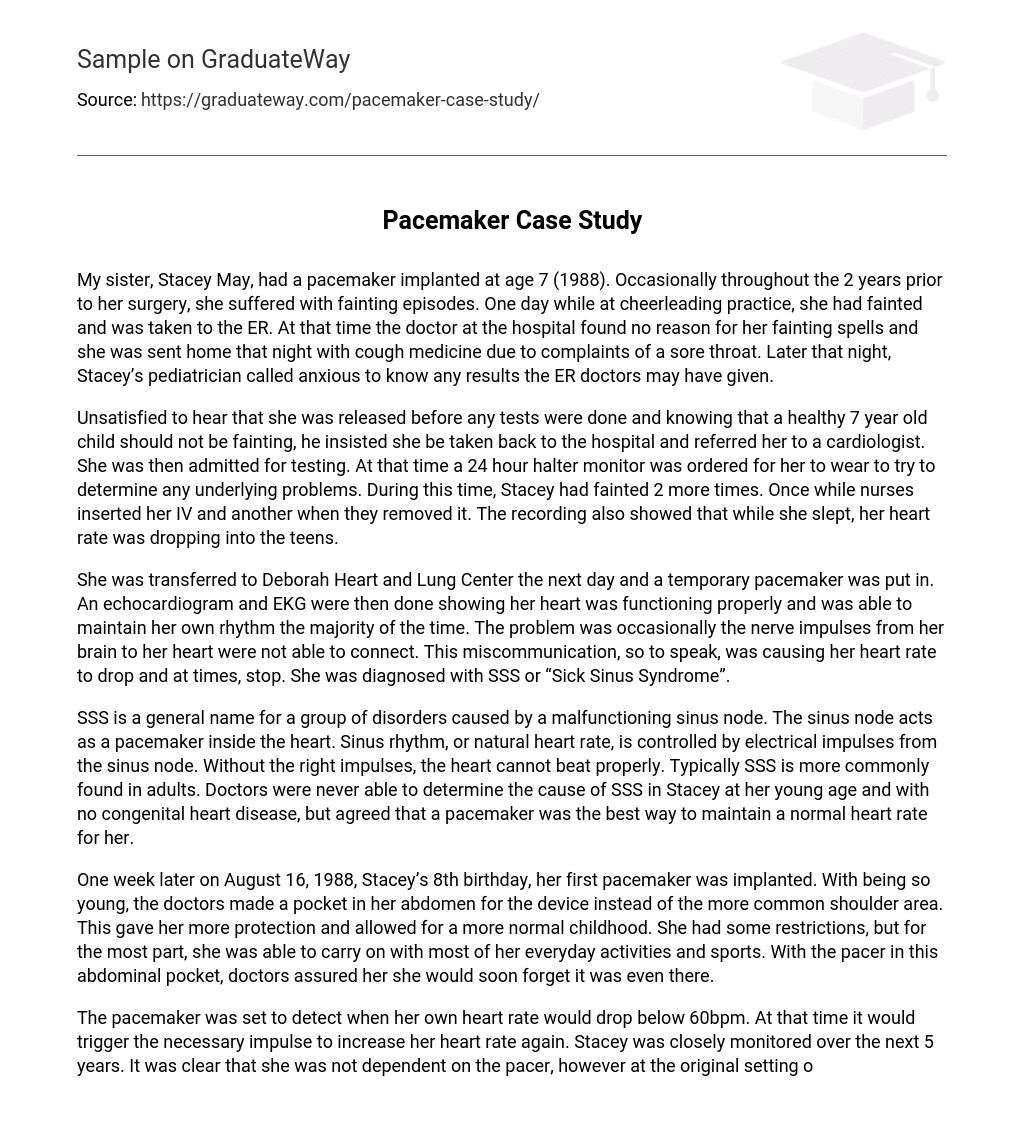My sister, Stacey May, had a pacemaker implanted at age 7 (1988). Occasionally throughout the 2 years prior to her surgery, she suffered with fainting episodes. One day while at cheerleading practice, she had fainted and was taken to the ER. At that time the doctor at the hospital found no reason for her fainting spells and she was sent home that night with cough medicine due to complaints of a sore throat. Later that night, Stacey’s pediatrician called anxious to know any results the ER doctors may have given.
Unsatisfied to hear that she was released before any tests were done and knowing that a healthy 7 year old child should not be fainting, he insisted she be taken back to the hospital and referred her to a cardiologist. She was then admitted for testing. At that time a 24 hour halter monitor was ordered for her to wear to try to determine any underlying problems. During this time, Stacey had fainted 2 more times. Once while nurses inserted her IV and another when they removed it. The recording also showed that while she slept, her heart rate was dropping into the teens.
She was transferred to Deborah Heart and Lung Center the next day and a temporary pacemaker was put in. An echocardiogram and EKG were then done showing her heart was functioning properly and was able to maintain her own rhythm the majority of the time. The problem was occasionally the nerve impulses from her brain to her heart were not able to connect. This miscommunication, so to speak, was causing her heart rate to drop and at times, stop. She was diagnosed with SSS or “Sick Sinus Syndrome”.
SSS is a general name for a group of disorders caused by a malfunctioning sinus node. The sinus node acts as a pacemaker inside the heart. Sinus rhythm, or natural heart rate, is controlled by electrical impulses from the sinus node. Without the right impulses, the heart cannot beat properly. Typically SSS is more commonly found in adults. Doctors were never able to determine the cause of SSS in Stacey at her young age and with no congenital heart disease, but agreed that a pacemaker was the best way to maintain a normal heart rate for her.
One week later on August 16, 1988, Stacey’s 8th birthday, her first pacemaker was implanted. With being so young, the doctors made a pocket in her abdomen for the device instead of the more common shoulder area. This gave her more protection and allowed for a more normal childhood. She had some restrictions, but for the most part, she was able to carry on with most of her everyday activities and sports. With the pacer in this abdominal pocket, doctors assured her she would soon forget it was even there.
The pacemaker was set to detect when her own heart rate would drop below 60bpm. At that time it would trigger the necessary impulse to increase her heart rate again. Stacey was closely monitored over the next 5 years. It was clear that she was not dependent on the pacer, however at the original setting of 60bpm, the device was being used even when it was not needed because it was set to close to normal resting rate. Unfortunately because of this, the batteries to the pacer were drained and needed to be recharged.
It was also found that the leads to the pacemaker were corroded with scar tissue and needed replacements as well. The only way to accomplish this is another surgery. A new pacemaker and leads were implanted in November of 1993. This time doctors set the pacer at 40bpm. At this new low setting, that same device had lasted the next 19 years and records show it has rarely been used. Two years ago, doctors began new series of tests to determine the actual need for the pacemaker at this time.
It is again time to charge the batteries but test results showed that over a 2 month period, she was on her own heart rhythm and at no time during these 2 months did she use the pacemaker. So after all these years, Stacey’s doctors agree it is safe to remove her pacemaker and she is now awaiting surgery. It is assumed that since it was a nerve disorder and not a heart problem, she may have grown out of the condition or with new technology it could be treated without the pacer. But at this time Stacey is showing no signs of SSS and the batteries have been drained for the last 6 months.





